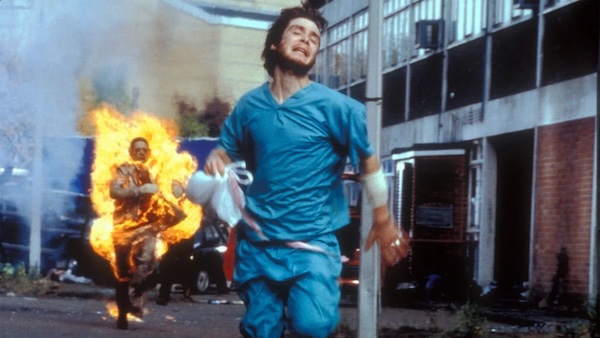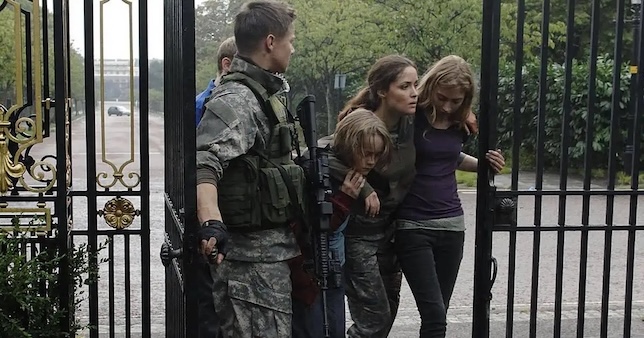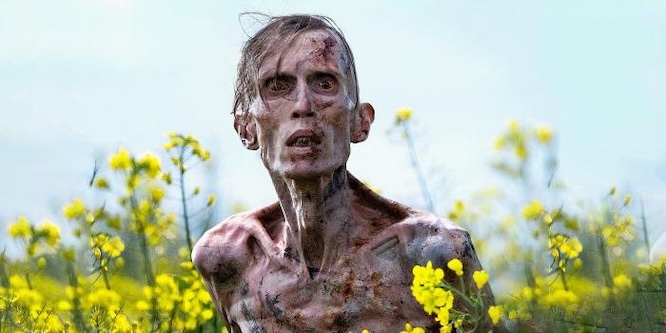Film Commentary: Zombie Apocalypse, Re-Imagined — The Legacy of “28 Days Later”
By Peg Aloi
Where is the grandiose zombie apocalypse that illuminates the grotesque reality of the death-denying yet death-obsessed beings we’ve become? Ralph Fiennes knows.

A scene from 28 Days Later
Let’s first agree that George Romero invented the zombie apocalypse film genre in 1968 with Night of the Living Dead, and that Danny Boyle and Alex Garland reinvigorated and redefined that genre with 28 Days Later in 2002. Interestingly, neither neither of these filmmakers uses the term “zombies.” Romero preferred the term “ghouls,” and Garland’s walking dead are merely “the infected.” Speaking of The Walking Dead, the iconic AMC series (which calls its undead “walkers”) borrowed heavily from 28 Days Later, including the plot point of having its main character hospitalized in a coma when the initial outbreak of a man-made virus occurs. The iconic look of the film (also endlessly influential) is in part thanks to the unique artistic vision and skills of cinematographer Anthony Dod Mantle, who once again joins Boyle and Garland in the third installment, 28 Years Later, opening today.
Garland’s screenplay for 28 Days Later exploded a number of zombie apocalypse genre norms viewers had grown to accept in the wake of Romero’s popular franchise. The conceit that people suddenly rose from the dead to start feasting on human flesh originates with Romero, with authorities blaming the scourge on radiation brought back from a recent space exploration trip to Venus. Venus! You know, goddess on the mountaintop, Roman deity of love, sex, and beauty. The source of the flesh-eating virus is (symbolically) feminine. Interestingly, Garland’s pathogen, which is engineered to infect people with rage, is also unleashed on humanity by a woman. A band of animal rights activists go on a mission to free infected lab monkeys. The first victim, and first human carrier, is a woman who opens one of the cages. An undeniable (and rather sexist, frankly) link with the menstrual cycle is also present: 28 days, irrepressible hunger, inexplicable “rage,” and, of course, the famous tagline “it’s in the blood.” Sex and sex roles are crucial aspects of Garland’s narrative.
In his subsequent films, as both writer and director, it is also worth noting that Garland made some controversial statements about sex and about women in particular (thinking mainly of Ex Machina and Men). One of the more compelling aspects of 28 Days Later is its unflinching vision of a world in crisis. It hones in on how easily civilized people revert to brutality and exploitation: for example, when a rogue military compound (led by Christopher Eccleston in a brilliantly chilling role) lures in frightened people with the promise of safety in order to procure women. Jim (Cillian Murphy) and Selena (Naomie Harris) have a teenage girl in their care when they stumble upon this patriarchal fortress, and must find a way to escape a fate that’s just as terrifying as being exposed to the infected hordes. This setup offers intriguing implications about the nature of infection (of body and mind), about rage, and about human society’s ability to survive intact.
The other genre-busting aspect of Garland and Boyle’s vision was the notion that the “infected” were not actually dead. These were rage-fueled, bloodthirsty cannibals devoid of humanity. Gone was the occasional charm and sexual allure of undead vampires. Instead of shuffling slowly along, moldering into decay, like Romero’s ghouls, these infected beings are fast: lean, wiry, and terrifying, and perpetually hungry,running madly towards their prey. The near-instantaneous impact of the “rage” virus — after the victim is bitten or exposed — means that anyone nearby must escape quickly or kill the recently-infected without hesitation. This dilemma prompted stunningly powerful moments, both in 28 Days Later (when Brendan Gleeson, a benevolent dad and competent survivor, is infected by a drop of blood from a carrion crow feasting on a body suspended overhead, understands immediately what is happening to him, and tells his daughter to run), and in 28 Weeks Later (Robert Carlyle is tortured because he must leave his wife, Catherine McCormack, to a horrific fate in order to save himself)

A scene from 28 Weeks Later.
This quicksilver conceit was also a somewhat oblique reference to the AIDS crisis, when a devastating virus was passed primarily through intimate contact. But AIDS was a disease that progressed comparatively slowly, whereas the rage virus is instantaneous. More to the point, given recent COVID history, both the 28 Days Later films and The Walking Dead emphasize the struggle to stay alive, even if it means leaving slower companions behind. This echoes our current precarious public health situation, in which many people suffering from long-term health impacts of the ongoing viral pandemic (fallen by the wayside, as it were) are receiving scarce options for treatment or support.
But I digress! Why would the third installment of an absurdly popular horror film franchise about a virus capable of destroying humanity bother to convey scary parallels to daily reality? Not to mention reference the encroaching fascism in the United States, a militarism that resembles the abusive, dehumanizing tactics of the armed mercenaries in 28 Days Later? 28 Weeks Later mostly portrayed the military as heroes. 28 Years Later (which opens today) gives us a brief glimpse of armed forces from Sweden deployed to help dispatch infected hordes who are now contained in the isolated nation of Great Britain (yeah, a slightly stronger anti-Brexit commentary would have been nice, but c’est la vie). The latest film also probes the influence of religious zealotry via a flashback to a child’s frightful experience. His home and siblings under attack from a crowd of the infected, a boy named Jimmy begs his father, a minister praying inside a church, for help. Smiling, his eyes alight with beatific delusion, the man of God sees the horrific invasion as a form of salvation. His son barely escapes with his life.

A scene from 28 Years Later.
The next scene is set twenty eight years later in a secluded community in the Scottish Highlands, separated from the mainland by an ancient causeway. There’s a fleeting but engaging portrait of a self-sustaining village, tightly-knit and bent on conserving resources (I’d have liked to see more of these characters explored). Some of the menfolk risk their safety to take part in macho escapades of “alpha” hunting (the sport of killing members of the infected who have been around since the beginning, still angry, still hungry, now stronger and perhaps craftier). Twelve-year-old Spike (a breakout performance from Alfie Williams) is initiated into this dangerous, rite-of-manhood activity by his father (the always-excellent Aaron Taylor-Johnson), whose wife Isla (the incomparable Jodie Comer of Killing Eve) is ill with some unknown malady. She is continually tired and confused (brain fog perhaps, or summer flu? How intentional are these eerie present-day parallels meant to be?) and cannot take part in the communal gatherings.
The small community and its ritualized practices reminded me instantly of the compelling HBO miniseries The Third Day, which starred Jude Law as a man drawn to a similarly isolated enclave with cult-like ways, whose disappearance prompts his estranged wife (Naomie Harris!) to find him. And, speaking of cults, we keep seeing odd graffiti mentioning someone named Jimmy…and then there is Ralph Fiennes as Ian Kelson, a former doctor who’s been living alone, burning a constant bonfire for nearly thirty years, and creating an epic work of art. It’s a subtle and precise performance from one of our greatest living actors.
There are some weak spots in 28 Years Later: scenes that are implausible (within this already outrageous situation), and annoyingly sentimental. These narrative misfires left me with unanswered questions and a sense of missed opportunity given our current state of affairs. Where is the grandiose zombie apocalypse that illuminates the grotesque reality of the death-denying yet death-obsessed beings we’ve become? Ralph Fiennes knows. Why, even in the midst of war, famine, environmental destruction, and unimaginable brutality, are we still figuring out how to take care of one another? Ralph Fiennes knows. Perhaps, in the next installment of this mesmerizing tale, Ralph Fiennes will tell all. May we still be here to listen.
Peg Aloi is a former film critic for the Boston Phoenix and member of the Boston Society of Film Critics, the Critics Choice Awards, and the Alliance for Women Film Journalists. She taught film studies in Boston for over a decade. She has written on film, TV, and culture for web publications like Time, Vice, Polygon, Bustle, Dread Central, Mic, Orlando Weekly, Refinery29, and Bloody Disgusting. Her blog “The Witching Hour” can be found on substack.
Tagged: "28 Days Later", "28 Weeks Later", Alex Garland, Danny Boyle, Jodie Comer
